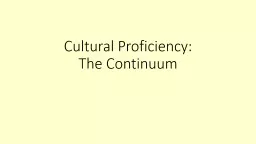

Cultural Proficiency Defined Cultural proficiency is a mindset a worldview a way a person or an organization make assumptions for effectively describing responding to and planning for issues that arise in diverse environments ID: 643834
Download Presentation The PPT/PDF document "Cultural Proficiency: The Continuum" is the property of its rightful owner. Permission is granted to download and print the materials on this web site for personal, non-commercial use only, and to display it on your personal computer provided you do not modify the materials and that you retain all copyright notices contained in the materials. By downloading content from our website, you accept the terms of this agreement.
Slide1
Cultural Proficiency:The ContinuumSlide2
Cultural Proficiency Defined
Cultural proficiency is a mind-set, a world-view, a way a person or an organization make assumptions for effectively describing, responding to, and planning for issues that arise in diverse environments.
In other words, cultural proficiency is a paradigm shift from viewing cultural differences as problematic to learning how to interact effectively with other cultures.
- Lindsey, Robins, & Terrell (2009)Slide3
Six Elements on the Cultural Proficiency Continuum
Arrange along a continuum
Six elements (white cards)
Match to the corresponding element
Definition of the six elements (yellow cards)
Abbreviated version of the definition of the elements (blue cards)
Examples of teacher statements (pink cards)Slide4
ElementsSlide5
Cultural DestructivenessSlide6
Cultural IncapacitySlide7
Cultural BlindnessSlide8
Cultural Pre-CompetenceSlide9
Cultural CompetenceSlide10
Cultural ProficiencySlide11
DescriptionsSlide12
Seeking to eliminate the cultures of others in all aspects of the school and in relationship to the community served.Slide13
Trivializing and stereotyping other cultures; seeking to make the cultures of others appear to be wrong or inferior to the dominant culture.Slide14
Not noticing or acknowledging the cultures of others within the school community; treating everyone in the educational system without recognizing that require differentiated interaction.Slide15
Increasing awareness of what you and the school don’t know about working in diverse settings; at this level of development, you and the school can move in a positive, constructive direction, or you can falter, stop, and possibly regress.Slide16
Aligning your personal values and behaviors, and the school’s policies and practices in a manner that is inclusive of cultures that are new or different from yours and the school’s; enables healthy and productive interactions.Slide17
Holding the vision that you and the school are the instruments for creating a socially just democracy; interacting with your colleagues, students, families, and the community as an advocate for life-long learning to serve effectively the educational needs of all cultural groups.Slide18
StatementsSlide19
See the differences and stomp it out. Slide20
See the differences and make it wrong. Slide21
See the difference and act like you don’t. Slide22
See the difference and at times, respond inappropriately. Slide23
See the difference and value it. Slide24
Seek the difference and esteem it as an advocate for equity. Slide25
QuotesSlide26
“In this class, we speak English only.”Slide27
“If we could get rid of our special needs students, our scores would improve.”Slide28
“A student made a derogatory remark and I used it as a teachable moment to remind students of the right thing to do.”Slide29
“The co-teach model with the push-in Special Education teacher is allowing us to have honest conversations about differentiation in the classroom
.”Slide30
“I don’t see color. I just see kids.”Slide31
“Racism and discrimination don’t exist anymore. I really hat it when parents use the race card.”Slide32
“You know that those parents never show up to school functions.”Slide33
“Asian students come to this country and succeed. Why wouldn’t the other students do so as well?.”Slide34
“Our school’s Social Justice and Equity Vertical Team is doing a great job of embedding culturally relevant lessons into our curriculum.”Slide35
“My job as an educator is not only to teach content. I also openly embrace my role as an advocate for each child and their family.”Slide36
“During Christmas time I have a menorah in my classroom.”Slide37
“We value all cultures. We have a night where parents bring food representing their country.”